Hardware video noise reduction, specifically for input to a MPEG encoder:
http://www.darvision.com/mfiltersa/index.shtml
Never used this and have no idea how well it works, oh well...
+ Reply to Thread
Results 31 to 60 of 82
-
Usually long gone and forgotten
-
This is a real-time mpeg2 capture using my DC1000 (source: an episode of Seinfeld, captured via s-video).

Not sure if this adds any value whatsoever to the conversation, but the original question asked about the DC1000.
I wonder if we all have some common source material (maybe some dvd or something) that we could all capture from the same frame, etc...)
Keith. -
I took a ~10 year old, ex-rental VHS tape, played it back on a several year old hand-me-down VHS player that only cost about US$60 when it was new, and captured it with my PVR-250 via a composite cable. This was about the worst I could find:
VBR 6400 kbps (DVD Standard Play template):
http://img88.exs.cx/my.php?loc=img88&image=vbr64005mf.png

CBR 15000 kbps:
http://img88.exs.cx/my.php?loc=img88&image=cbr150003wc.png

In this scene the people were moving, the camera was panning, and of course the water was splashing. The PVR's spatial and temporal noise filters were turned off, the sharping filter was set to zero. -
No price on the website so I called them (what the hell they have a toll free number) and the price is $700.00 USD plus UPS shipping (for me this would only be about $7.00 and I am on the opposite coast so at least the shipping is not a rip-off).Originally Posted by TheFamilyMan
There is a "bad" link for a PDF brochure but I was told that this is because the PDF is being worked on and therefore is not available yet.
They are sending me a hard copy brochure through the mail but it is for the PCI version yet the features etc. would be essentially the same as the stand alone unit. They claimed to only have this one brochure for the PCI version and nothing else to offer!
I have no idea why I requested it though ... I surely do NOT have $700 to blow on this
- John "FulciLives" Coleman"The eyes are the first thing that you have to destroy ... because they have seen too many bad things" - Lucio Fulci
EXPLORE THE FILMS OF LUCIO FULCI - THE MAESTRO OF GORE
-
Would be nice to know the used bitrate too!Originally Posted by rkgibbons
It looks pretty good, nice colours. -
What The_Doman has posted together with rkgibbons is no doubt good or very good. Sharpness, no color bleeding no visible artifacts... that speaks for itself. I think everyone should strive to give a good account of his/her experience, not something that just looks OK. I'm sorry junkmalle but your submissions are below standard and make judgment almost impossible (high movement, blurry shots - useless). Seinfeld capture is a plain example that MPEG2 capture is as viable as anything else.
Reboot, what was the point of posting the same picture again in this thread? Is this the ONLY good one you have made? What good is the capture if more then 50% of screen is black? Now, look at The_Doman stuff and ask yourself how to match it. Not in quality but in clear and plainly visible depiction of card capabilities. TO ALL, make sure that your caps are of "some" quality, avoid putting crap here. Doesn't help anyone.
Sorry about harsh tone but this forum iis not a garbage can, select your stuff carefully. -
Junkmalle your caps look decent but they have the typical Hauppauge "grid of blocks" effect that pisses me off so much when I see it. WHY is it THERE dammit?
Look, here in case anyone hasn't noticed... I will draw red lines to illustrate the grid of blocks effect. This is from the first pic, where it is really bad, this is how my caps are too usually, or worse:

In the second image the grid blocks aren't as bad (they shouldn't be at such a high bitrate!) but they are still there:

This seems to be unique to the Hauppauge products. My dad has a standalone USB capture device made by Hauppauge that exibits this same type of grid of blocks over the whole screen, only it's even worse. -
I thought it was obvious -- my whole point was to show a worst case scenario. And this is the problem that Hellbore is refering too. Everyone knows the PVR-250 does fine with clean signals and easily compressed content.Originally Posted by proxyx99
Hellbore, just to make the problems more obvious, here are the same areas enlarged with a nearest neighbor filter so you can see each pixel:
VBR 6400:
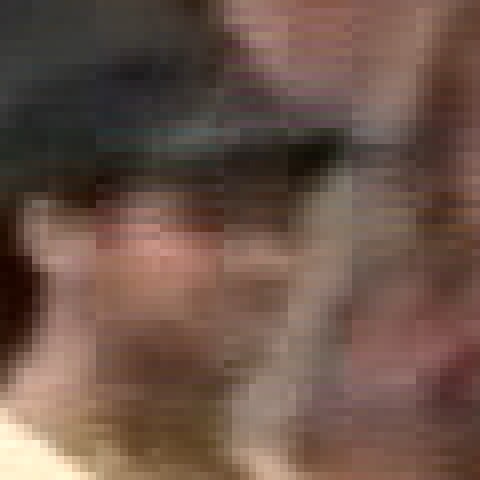
CBR 15000:
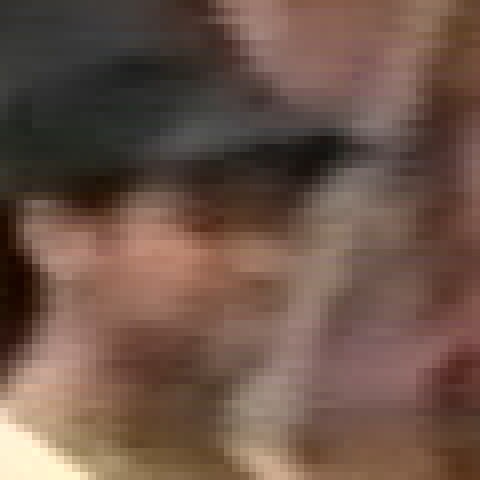
Some issues I should point out:
The vhs signal is very noisy. And I intentionally turned off the PVR-250 noise reduction so as not to mask it.
I had the PVR's sharpness setting set to 0. It doesn't sharpen low bandwidth content appreciably. It mostly ends up accentuating the noise!
The comb lines you see in the original images is not because this is an interlaced frame of a 3:2 pulldown, this is a progressive frame. The comb lines are there because the crappy player can't regulate the head speed well enough to keep the fields aligned. If you examine the vertical edges in the original picture (light pole, edges of the building) you'll see that they have a wavey distortion too.
These problems make it very difficult to compress the video. The field/scanline misalignement alone virtually guarantees that every pixel is different in every frame and no motion vectors will be able to account for it. -
Well, you have succeded... it is a ...disaster. Now, if you can, try to illustrate the "obvious", the "shiny" part of PVR-250.Originally Posted by junkmalle
-
I've heard the Canopus MPEG converters are not very good, advice given to me several times by several pros.
The Pinnacle is always regarded to have high quality .... IF IT WORKS! Pinnacle products are littered with bugs and flaws.
Matrox supposedly has some weel regarded MPEG hardware cards (RT cards), but those are $1000 or more.Want my help? Ask here! (not via PM!)
FAQs: Best Blank Discs • Best TBCs • Best VCRs for capture • Restore VHS -
Here's the same video captured by a traditional capture card -- an old Matrox eTV card that captures YUY2, saved with HuffYUV:
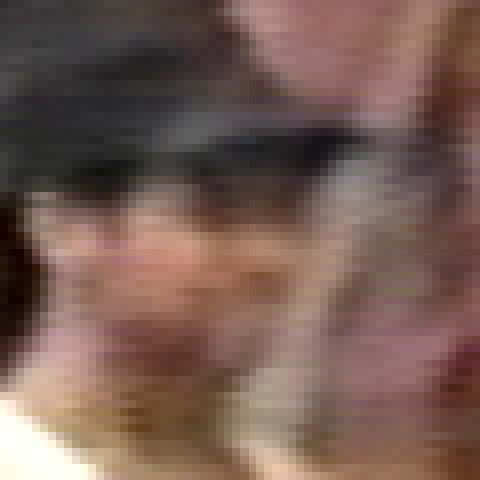
I converted that segment to MPG2 with Tmpgenc at 8000 kbps CBR (no filtering, etc):
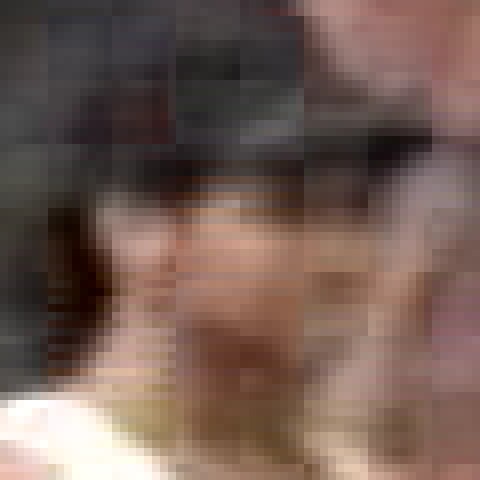
and the full tmpgenc frame:
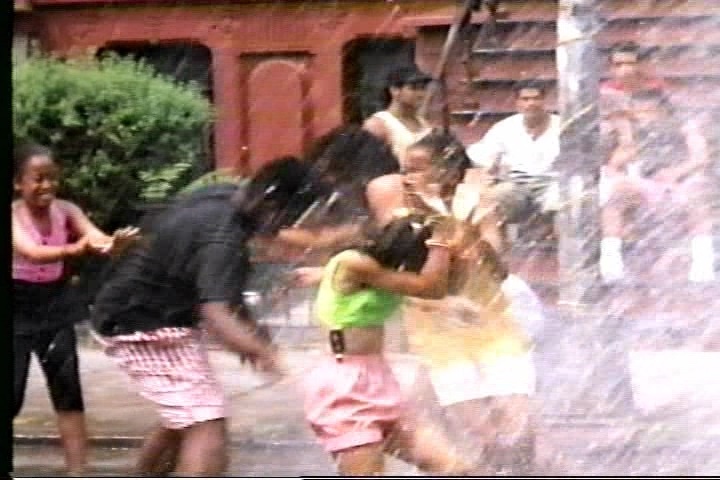
Which I think is even worse than the PVR-250 at 6400 kbps VBR. -
@ junkmalle
The reason (answer) to YOUR specific issues with your pic images are this:
* The Macro Blocks were always there.
Assumpsions on above ...
I would assume that when you recorded this signal, that it had these macro
blocks. I knew this before you even evidence the pics just above. But,
when you mentioned your same follow-up experience w/ another capture card
(using huffy) that settled it in my mind, that these macro blocks are *NOT*
due to the hardware mpeg-2 cards, but are due to the *SOURCE* materials,
which I have had the suspcions of, for quite some time now.., but mostly
thanks to direcTV for promoting such mirrored examples as your's. That's
one reason why I gave them up, and save myself a few dollars.
Now. If anyone else is experiencing these same issues as junkmalle's, than
I would chuck it off to the *SOURCE* already having this blocks. There is
nothing that you can do about it. Sure you can use filters, however.
Also, it would be wise to rule the above macro blocks out first. Then,
ponder about your given source issues.
.
In a given (planned) capture, capture some scenes first, to AVI. Examine
them for any macro blocks. I guarantee you, in most cases, you'll find
such macro blocks in your AVI file (after examining it) if your source is
from Satellite for instance. This is, of course, assuming that your
source is digital satellite/cable. Just remember, that anything
digital will most likely have macro blocks becuase of the encoding
to MPEG-2 source, among other things.
.
Should you find such macro blocks, then at least you know, its not your
hardware mpeg-2 capture device. And you won't have to blaim it. But your
next step might be, do you really want the satellite or not. Maybe you can
live with the macro blocks. Maybe not.
.
If you want maximum quality, nothing will beat a straight Analog Source.
That means, good old cable. (Not digital cable, because that would mean
macro blocks)
.
So, where do all these macro blocks come from ? Good question. They come
from the MPEG-2 that they output to your satellite receiver. There are
other glitches/issues about this, but I won't go into it here. Anyways.
Here are some items to consider:
* If your source (vhs/cable/satellite) is clean, (ie, not macro blocks, and
.. no noise, such as static)
.. Any device (Hardware or Analog) will yield maximum quality output.
.. Course, an Analog capture device will out-perform an hardware mpeg-2 device
.. (if operated by a skilled user)
* Some capture devices do better at Interlace frames (3:2 pattern, or pure
.. interlace frames) Capture devices will no doubt do better when the source
.. is Progressive, every frame.
.. .
.. But, a good measurement for one's capture device, is the bitrate numbers
.. used. The lower the bitrate, and quality still mainted, the better the
.. reference. That is, if you obtain excellent quality froma 5k capture, and
.. the source is Cable (and no noise) then that is the starting reference to
.. opt for. Should someone else receive better, using the same setup and
.. source device and material, then *that* becomes the new reference to opt
.. for. (to shoot for) (see notes below)
.. .
.. I think that another good 'test scenario' should be taken with pure interlace
.. source. But, something that we all can partake in, (using the same source)
.. that we can gauge our capture cards/devices against. This way, we can see
.. for ouselves, weather our given setup (cards) can make it or not.
.. .
.. The reason why I say 'pure interlace' (where every frame is interelace, as in
.. News; Sports; Weather channel) is because this is a source type that gives
.. the most problematic final output quality. Most of us that use Procoder
.. for pure interlace source know that it rain's as 'king' in this area.
.. So far, I have not seen any hardware mpeg-2 device do better at a given
.. bitrate. (But then you have to set a reference goal to aim for. And that
.. reference has to be a minimum to shoot for, then nudging upwards, till it
.. brakes, resulting in poor quality)
* When demoing a given captuer cards CONS/PROS, it would be wise to use
.. something that can be *gauged* on, by other users here, so that they can
.. duplicate similar results with there cards. You have to understand, that
.. there will be users here, that will have the same source, and the same
.. card. They will want to try the same test run. But, it would frustrate
.. them, if you use a reference source/material that is not obtainable.
.. .
.. For the sake of demoing purposes, one should strive to use a common reference
.. source.
.. .
.. For instance, give the following some thought:
.. * source device ---- (ie, dvd player)
.. * source material -- (ie, commercial DVD and VHS movie)
.. .. you can exclude cable/satellite/antenna, because not everyone will
.. .. have the same channel package to duplicate tests with)
.. .
.. Then, run your test demos again. (choose wisely, your scenes, from both
.. source materials (vhs and dvd) ie, make an action scene pic, and a still
.. scene pic, and maybe a few more other scene pics)
.. .
.. Make it easy for others to follow, by including the steps you used to
.. obtain the scenes. ie, chapters; time markers; frames; length; etc.
.. .
.. Don't forget to include the software apps you used in the above.
.. .
.. This way, other users might be able to run the same setup, and can share
.. in the success (or not success) in this scenario.
.. .
.. If however, the user's test (based on the above consensus test) then *that*
.. user can take some time, and think about wether its time to upgrade their
.. capture device or not. But at least they know where they stand in there
.. capture setup. If they are looking for maximum throughput, the above
.. scenario might benefit them wisely
-vhelp 3230 -
Could you point out the macroblocks in the the above Matrox/HuffYUV sample? I don't see any. Keep in mind it is an 8x enlargement with a nearest neighbor algorithm -- specifically so you can see each source pixel (as an 8x8 block).Originally Posted by vhelp
Here are the DCT macroblocks from the image after conversion to MPEG with TmpgEnc (hilited from the above image):
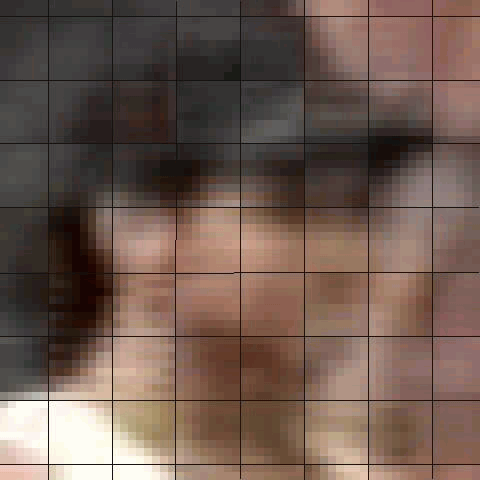
-
As suggested, why don't we abandon the old VHS source, and try to come up with a common source that we can all compare.
-
Hellbore (who started this thread) is capturing from VHS:
https://www.videohelp.com/forum/viewtopic.php?p=1255969#1255969
https://www.videohelp.com/forum/viewtopic.php?p=1248157
He does have a TBC though. -
Initial post was not calling for direct comparison or quality analysis but rather for examples of what can be expected from a "better" quality card as opposed to mainstream stuff (read: junk). Why did I say junk? Look how much haggling, proving, covincing is involved in presenting a regular card. Better stuff (upon viewing) should be like "yeah, that's what I meant!". So let's talk about what it could be like rather then saying that wintv2000 can also do the job (barely). Hellbore was asking for examples of better stuff (semi-pro or pro quality). Avermedia, Leadtek, Hauppage or similar do not fall into this cat. no matter how convincing you guys may sound.
-
...which is why I included the DC1000 mpeg capture. I think it demonstrates that the higher priced cards can produce some pretty impressive results (even at rather modest settings). The DC1000 can capture in mpeg up to 15Mbit/s, and in a proprietary AVI format up to 25Mbit/s.
-
If Hellbore will send you his tape, VCR, and TBC we can see a fair comparison!Originally Posted by rkgibbons
-
Just so you can compare, here is an example of the kind of captures I am getting. This is 7 mbit CBR captured from a VHS using JVC HR-S9911U, through an I.DEN IVT-7 full-frame TBC with proc amp settings tweaked a bit, through a SignVideo DR-1000 detailer (detail and sharpness knobs turned all the way down)

You can still see the DCT macroblocks even though they don't seem as bad in this frame as in some others. I should probably show you the worse ones... -
Your video is noisy. Up the bitrate. All tv's hide some degree of problems. Higher end equipment is equipped with DNR that fights minor issues.
I see nothing here of any consequence. Perfectionist bickering.
If you hate compression artifacts, then quit using VHS as the source, and quit encoding to a compressed MEPG format.Want my help? Ask here! (not via PM!)
FAQs: Best Blank Discs • Best TBCs • Best VCRs for capture • Restore VHS -
I agree now that I see this close-up image of the girl ... it looks damn fine for a MPEG-2 DVD spec capture from a VHS source.Originally Posted by lordsmurf
VHS is VHS and that is how it is.
It can only be so good since VHS is a suck ass format.
- John "FulciLives" Coleman"The eyes are the first thing that you have to destroy ... because they have seen too many bad things" - Lucio Fulci
EXPLORE THE FILMS OF LUCIO FULCI - THE MAESTRO OF GORE
-
Yeah but it still has the MACROBLOCKS.... Are you tellin me it's impossible to get rid of them with this source? Isn't there anything I can do about the noise? I have a JVC with DigiPure DNR enabled and I have the Hauppauge set to the default noise reduction settings.
The problem is those MACROBLOCKS become very easily visible on our TV. Anyone with a big screen TV would be able to see them. The capture looks great on a smaller TV around 30" or less but on a big TV it looks bad.
The source VHS looks fine on a big TV.
That is what is driving me nuts here. I want to preserve our videos with a copy that doesn't look WORSE than the original!
I'm gonna have to try encoding the same source with software encoders and see if they do any better. You guys are telling me it won't get any better though right? We'll have to see.
Oh and by the way LordSmurf, I can't up the bitrate by much, since normal DVD players tend to have problems with anything over 8 or 9 mbits right? So what am I supposed to do, just say "oh well"? -
Here look, a sample of motion, it is even blockier and the blocks are more obvious. It becomes annoying on a big screen TV.

Notice how noticeable they are around my legs (I'm the guy on the left).
they are around my legs (I'm the guy on the left).
Also how can I de-interlace these things so I can show you better samples? They look really stupid the way I am posting them. -
The only other option you have with the WinTV PVR-250 is to record at a MPEG-2 CBR of 15,000kbps then re-encode to MPEG-2 DVD standard (say a CBR of 7500kbps with PCM WAV audio or a CBR of 8000kbps with AC-3 audio) with a software encoder which will then allow you to use some software filters that might help the encoding go smoother. I'm thinking of the "noise filter" built-in to TMPGEnc Plus or better yet something that works with AviSynth like the Convolution3D filter.
However you already are sending a fairly clean signal to the WinTV PVR-250 since you use the JVC S-VHS and a TBC (which tends to soften the image) and an image thing-a-ma-doo that is even futher softening the image so ... maybe you cannot make it better.
However everyone seems to think that ProCoder is best with purely interlaced footage (such as what you get from camcorder footage) so maybe doing what I say but using ProCoder on the computer side will help somewhat.
VHS was never meants for a large screen. I can't stand VHS on anything more than a 27" myself.
- John "FulciLives" Coleman"The eyes are the first thing that you have to destroy ... because they have seen too many bad things" - Lucio Fulci
EXPLORE THE FILMS OF LUCIO FULCI - THE MAESTRO OF GORE
-
Truer words were never spoken.Originally Posted by FulciLivesWant my help? Ask here! (not via PM!)
FAQs: Best Blank Discs • Best TBCs • Best VCRs for capture • Restore VHS -
You could have corrected my grammer so it reads "meant" instead of "meants" LOLOriginally Posted by lordsmurf

- John "FulciLives" Coleman"The eyes are the first thing that you have to destroy ... because they have seen too many bad things" - Lucio Fulci
EXPLORE THE FILMS OF LUCIO FULCI - THE MAESTRO OF GORE
-
Although I haven't tried a computer hardware MPEG2 encoding card, I have found that using either the JVC or Pioneer standalone DVD recorders as hardware MPEG2 encoders works pretty darn well. At the highest quality settings (1 hour per disc, 9+Mbps average bitrate), hand held home video camcorder footage comes out looking virtually identical to the original, with very little or no macroblocking. These machines offer their own pre-encoding video procressing and noise reduction filtering that leads great looking encodes. Since you can by a used (or even new) Pioneer DVR-220 or JVC DR-M10 for less than $200, you might give that a try. The results I get with mine are easily better than what I was able to produce with my computer capturing setup.
-
Gshelley got any examples of home video VHS footage captured using standalone DVD recorder?
Also if I go this route, does the device have a way of sending it to my PC or do I have to burn it to DVD using the recorder, then put that DVD in my PC to edit it?
Similar Threads
-
Sources for high-end VCRs considered
By sanlyn in forum Capturing and VCRReplies: 0Last Post: 29th Jan 2012, 09:57 -
Video Playback problem on high end PC
By hsn_kmr in forum Video Streaming DownloadingReplies: 0Last Post: 5th Oct 2011, 06:45 -
low end quadro is 5 times faster than high end gaming card
By deadrats in forum ComputerReplies: 4Last Post: 7th Apr 2011, 16:42 -
Software Encoding on High-End System
By tbradyjd in forum Capturing and VCRReplies: 4Last Post: 19th Feb 2010, 22:36 -
Best hardware mpeg2 encoder (under 700 $)?
By Speed Demon in forum Capturing and VCRReplies: 27Last Post: 6th Sep 2007, 11:01




 Quote
Quote